Business Law Report: Kango - Employment, Contracts, and Disputes
VerifiedAdded on 2021/02/21
|10
|3066
|161
Report
AI Summary
This report provides a comprehensive analysis of business law, focusing on the case of Kango, a food retailer. It begins by exploring the primary and secondary sources of law in the UK, including legislation, case law, textbooks, and court decisions. The report then examines the role of the government in law-making and explains how statutory and common law are applied in the courts. A significant portion of the report is dedicated to assessing the impact of employment, company, and contract laws on Kango's business, particularly concerning its self-employed delivery staff. It highlights the differences between employed and self-employed individuals and the legal challenges faced by companies like Kango. The report also explores the legal formation of different types of business organizations in the UK, including limited companies, sole traders, and partnerships. Furthermore, it discusses how business organizations are managed and funded. Finally, the report recommends legal solutions for resolving disputes, offering insights into alternative dispute resolution methods. The report emphasizes the importance of adhering to relevant laws, such as the General Food Law Regulation and the Food Safety Act 1990, for Kango's operations.
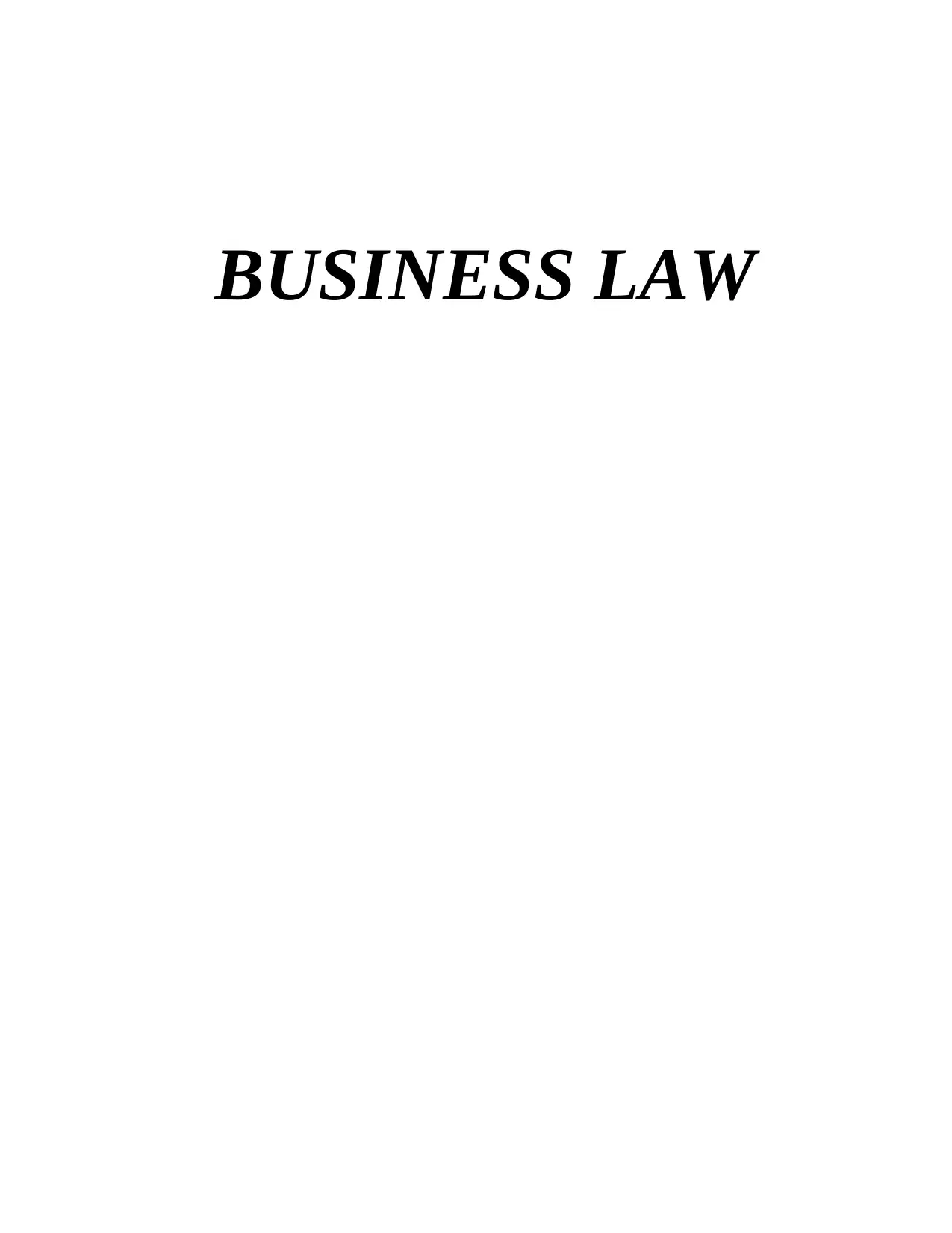
BUSINESS LAW
Paraphrase This Document
Need a fresh take? Get an instant paraphrase of this document with our AI Paraphraser
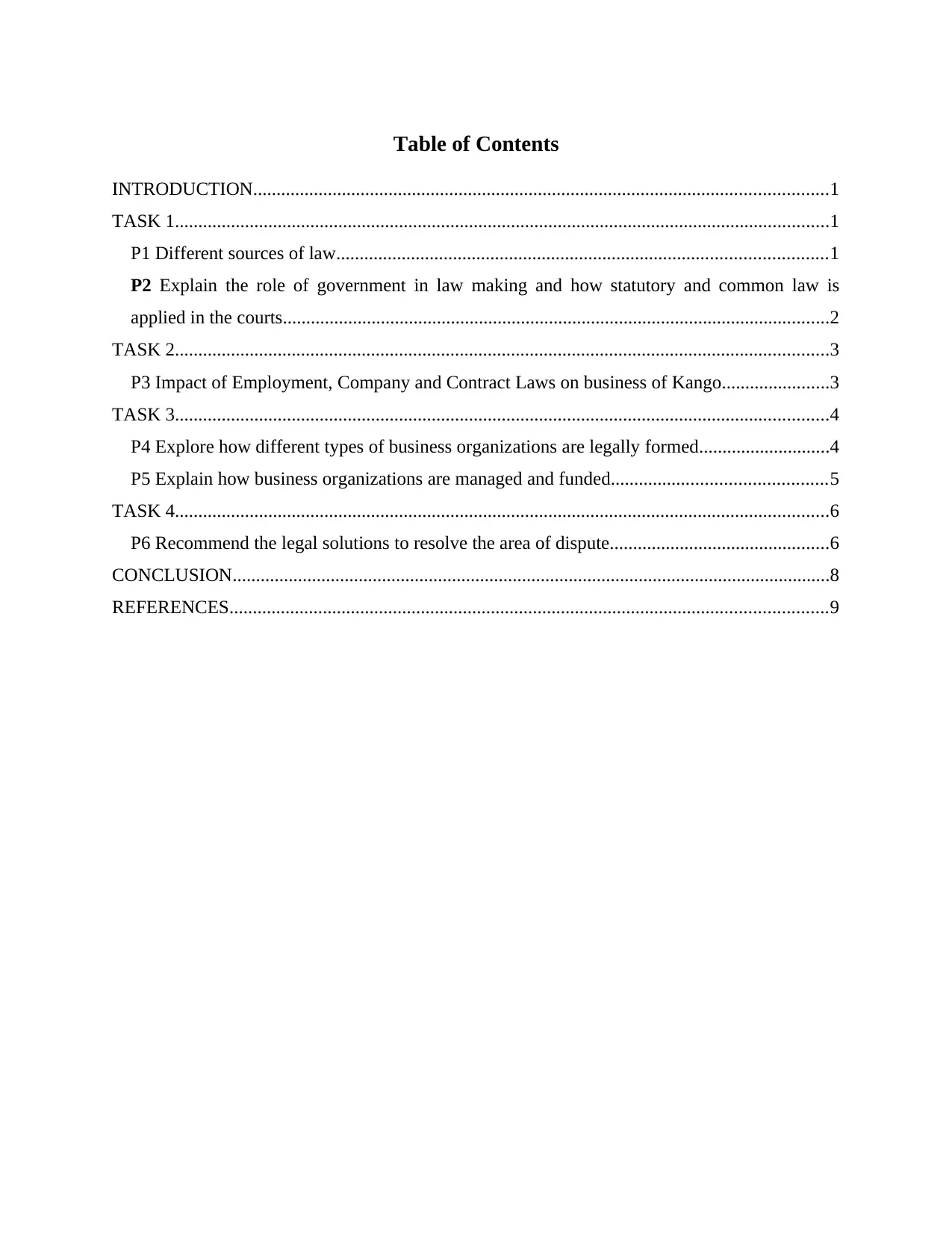
Table of Contents
INTRODUCTION...........................................................................................................................1
TASK 1............................................................................................................................................1
P1 Different sources of law.........................................................................................................1
P2 Explain the role of government in law making and how statutory and common law is
applied in the courts.....................................................................................................................2
TASK 2............................................................................................................................................3
P3 Impact of Employment, Company and Contract Laws on business of Kango.......................3
TASK 3............................................................................................................................................4
P4 Explore how different types of business organizations are legally formed............................4
P5 Explain how business organizations are managed and funded..............................................5
TASK 4............................................................................................................................................6
P6 Recommend the legal solutions to resolve the area of dispute...............................................6
CONCLUSION................................................................................................................................8
REFERENCES................................................................................................................................9
INTRODUCTION...........................................................................................................................1
TASK 1............................................................................................................................................1
P1 Different sources of law.........................................................................................................1
P2 Explain the role of government in law making and how statutory and common law is
applied in the courts.....................................................................................................................2
TASK 2............................................................................................................................................3
P3 Impact of Employment, Company and Contract Laws on business of Kango.......................3
TASK 3............................................................................................................................................4
P4 Explore how different types of business organizations are legally formed............................4
P5 Explain how business organizations are managed and funded..............................................5
TASK 4............................................................................................................................................6
P6 Recommend the legal solutions to resolve the area of dispute...............................................6
CONCLUSION................................................................................................................................8
REFERENCES................................................................................................................................9
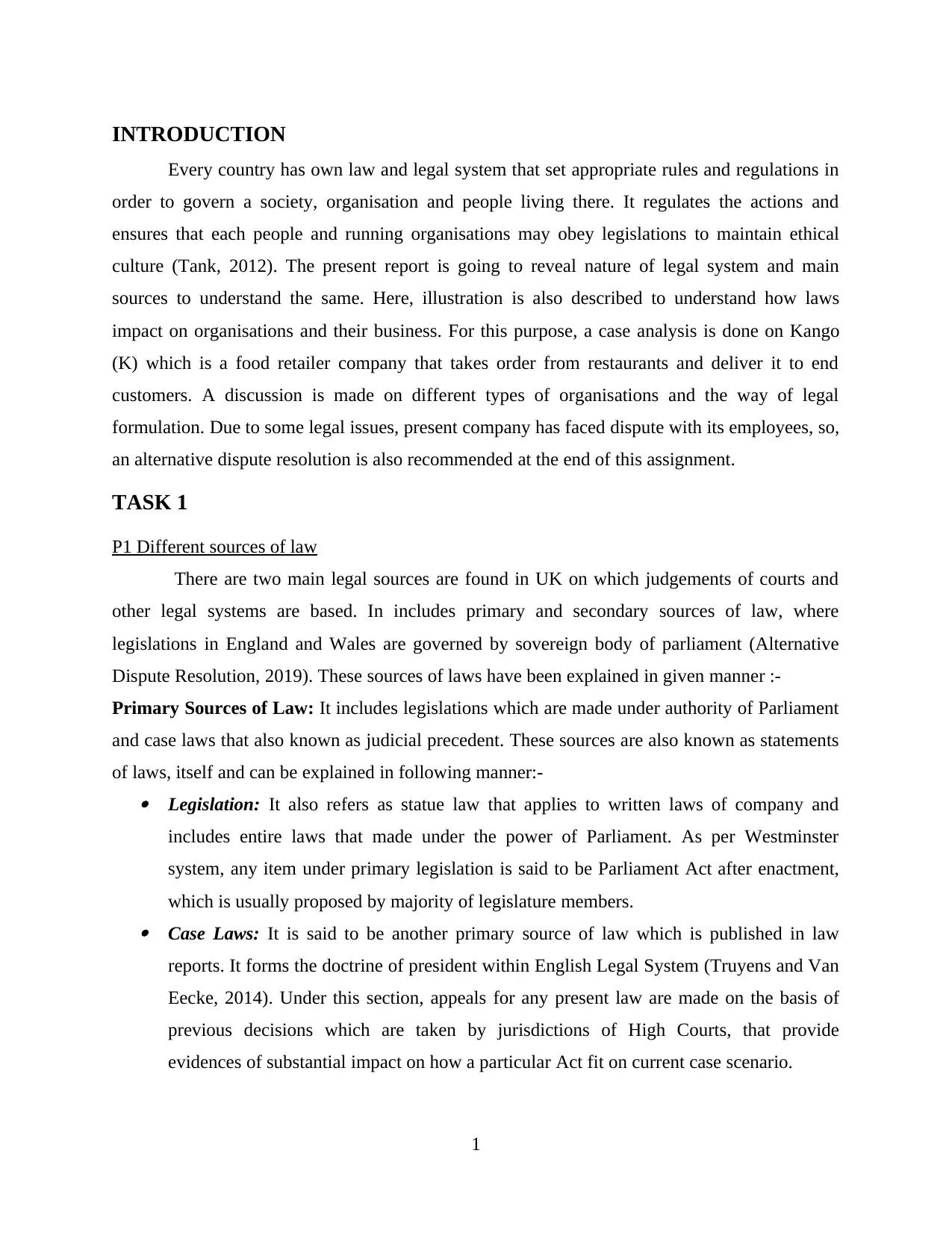
INTRODUCTION
Every country has own law and legal system that set appropriate rules and regulations in
order to govern a society, organisation and people living there. It regulates the actions and
ensures that each people and running organisations may obey legislations to maintain ethical
culture (Tank, 2012). The present report is going to reveal nature of legal system and main
sources to understand the same. Here, illustration is also described to understand how laws
impact on organisations and their business. For this purpose, a case analysis is done on Kango
(K) which is a food retailer company that takes order from restaurants and deliver it to end
customers. A discussion is made on different types of organisations and the way of legal
formulation. Due to some legal issues, present company has faced dispute with its employees, so,
an alternative dispute resolution is also recommended at the end of this assignment.
TASK 1
P1 Different sources of law
There are two main legal sources are found in UK on which judgements of courts and
other legal systems are based. In includes primary and secondary sources of law, where
legislations in England and Wales are governed by sovereign body of parliament (Alternative
Dispute Resolution, 2019). These sources of laws have been explained in given manner :-
Primary Sources of Law: It includes legislations which are made under authority of Parliament
and case laws that also known as judicial precedent. These sources are also known as statements
of laws, itself and can be explained in following manner:- Legislation: It also refers as statue law that applies to written laws of company and
includes entire laws that made under the power of Parliament. As per Westminster
system, any item under primary legislation is said to be Parliament Act after enactment,
which is usually proposed by majority of legislature members. Case Laws: It is said to be another primary source of law which is published in law
reports. It forms the doctrine of president within English Legal System (Truyens and Van
Eecke, 2014). Under this section, appeals for any present law are made on the basis of
previous decisions which are taken by jurisdictions of High Courts, that provide
evidences of substantial impact on how a particular Act fit on current case scenario.
1
Every country has own law and legal system that set appropriate rules and regulations in
order to govern a society, organisation and people living there. It regulates the actions and
ensures that each people and running organisations may obey legislations to maintain ethical
culture (Tank, 2012). The present report is going to reveal nature of legal system and main
sources to understand the same. Here, illustration is also described to understand how laws
impact on organisations and their business. For this purpose, a case analysis is done on Kango
(K) which is a food retailer company that takes order from restaurants and deliver it to end
customers. A discussion is made on different types of organisations and the way of legal
formulation. Due to some legal issues, present company has faced dispute with its employees, so,
an alternative dispute resolution is also recommended at the end of this assignment.
TASK 1
P1 Different sources of law
There are two main legal sources are found in UK on which judgements of courts and
other legal systems are based. In includes primary and secondary sources of law, where
legislations in England and Wales are governed by sovereign body of parliament (Alternative
Dispute Resolution, 2019). These sources of laws have been explained in given manner :-
Primary Sources of Law: It includes legislations which are made under authority of Parliament
and case laws that also known as judicial precedent. These sources are also known as statements
of laws, itself and can be explained in following manner:- Legislation: It also refers as statue law that applies to written laws of company and
includes entire laws that made under the power of Parliament. As per Westminster
system, any item under primary legislation is said to be Parliament Act after enactment,
which is usually proposed by majority of legislature members. Case Laws: It is said to be another primary source of law which is published in law
reports. It forms the doctrine of president within English Legal System (Truyens and Van
Eecke, 2014). Under this section, appeals for any present law are made on the basis of
previous decisions which are taken by jurisdictions of High Courts, that provide
evidences of substantial impact on how a particular Act fit on current case scenario.
1
⊘ This is a preview!⊘
Do you want full access?
Subscribe today to unlock all pages.

Trusted by 1+ million students worldwide
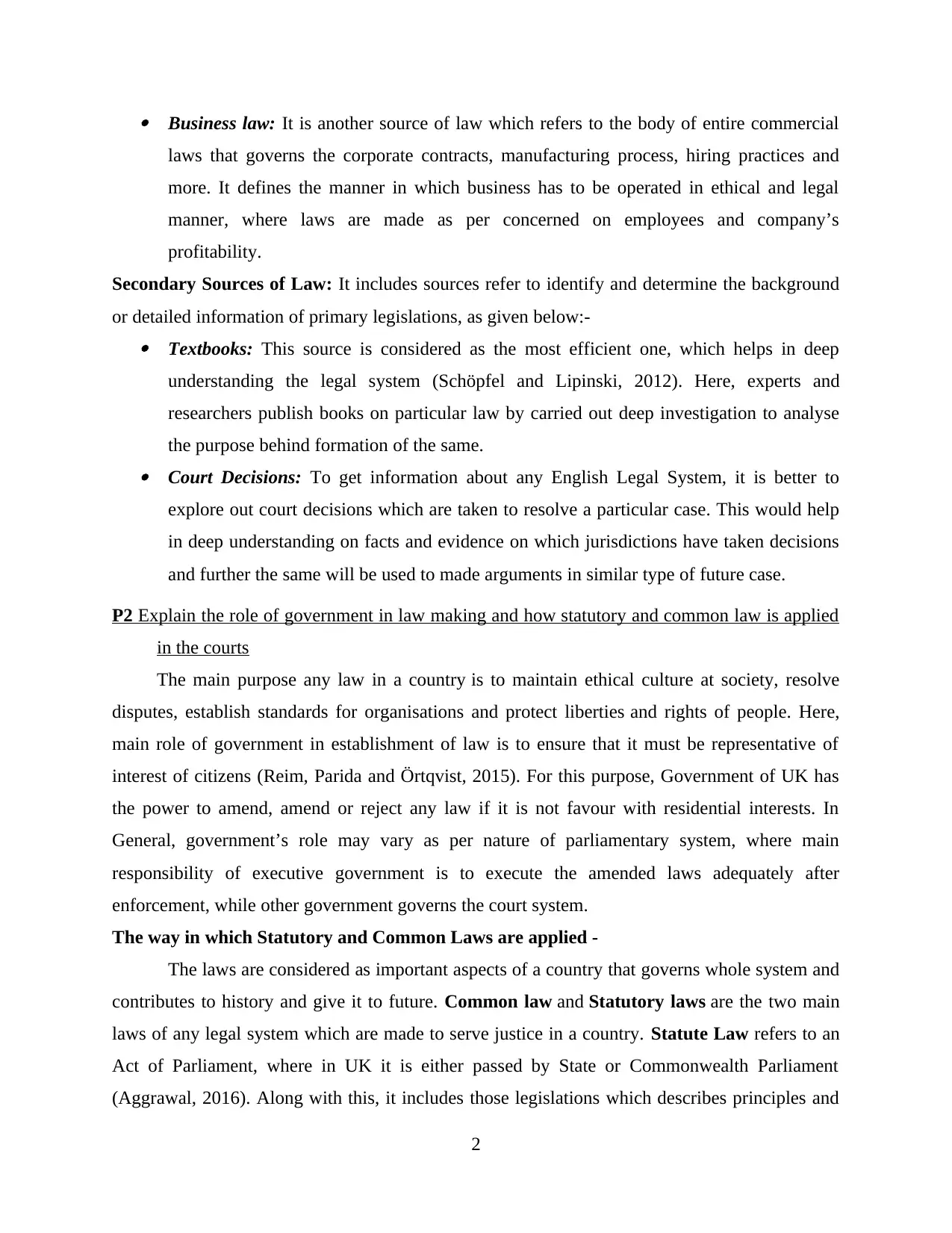
Business law: It is another source of law which refers to the body of entire commercial
laws that governs the corporate contracts, manufacturing process, hiring practices and
more. It defines the manner in which business has to be operated in ethical and legal
manner, where laws are made as per concerned on employees and company’s
profitability.
Secondary Sources of Law: It includes sources refer to identify and determine the background
or detailed information of primary legislations, as given below:- Textbooks: This source is considered as the most efficient one, which helps in deep
understanding the legal system (Schöpfel and Lipinski, 2012). Here, experts and
researchers publish books on particular law by carried out deep investigation to analyse
the purpose behind formation of the same. Court Decisions: To get information about any English Legal System, it is better to
explore out court decisions which are taken to resolve a particular case. This would help
in deep understanding on facts and evidence on which jurisdictions have taken decisions
and further the same will be used to made arguments in similar type of future case.
P2 Explain the role of government in law making and how statutory and common law is applied
in the courts
The main purpose any law in a country is to maintain ethical culture at society, resolve
disputes, establish standards for organisations and protect liberties and rights of people. Here,
main role of government in establishment of law is to ensure that it must be representative of
interest of citizens (Reim, Parida and Örtqvist, 2015). For this purpose, Government of UK has
the power to amend, amend or reject any law if it is not favour with residential interests. In
General, government’s role may vary as per nature of parliamentary system, where main
responsibility of executive government is to execute the amended laws adequately after
enforcement, while other government governs the court system.
The way in which Statutory and Common Laws are applied -
The laws are considered as important aspects of a country that governs whole system and
contributes to history and give it to future. Common law and Statutory laws are the two main
laws of any legal system which are made to serve justice in a country. Statute Law refers to an
Act of Parliament, where in UK it is either passed by State or Commonwealth Parliament
(Aggrawal, 2016). Along with this, it includes those legislations which describes principles and
2
laws that governs the corporate contracts, manufacturing process, hiring practices and
more. It defines the manner in which business has to be operated in ethical and legal
manner, where laws are made as per concerned on employees and company’s
profitability.
Secondary Sources of Law: It includes sources refer to identify and determine the background
or detailed information of primary legislations, as given below:- Textbooks: This source is considered as the most efficient one, which helps in deep
understanding the legal system (Schöpfel and Lipinski, 2012). Here, experts and
researchers publish books on particular law by carried out deep investigation to analyse
the purpose behind formation of the same. Court Decisions: To get information about any English Legal System, it is better to
explore out court decisions which are taken to resolve a particular case. This would help
in deep understanding on facts and evidence on which jurisdictions have taken decisions
and further the same will be used to made arguments in similar type of future case.
P2 Explain the role of government in law making and how statutory and common law is applied
in the courts
The main purpose any law in a country is to maintain ethical culture at society, resolve
disputes, establish standards for organisations and protect liberties and rights of people. Here,
main role of government in establishment of law is to ensure that it must be representative of
interest of citizens (Reim, Parida and Örtqvist, 2015). For this purpose, Government of UK has
the power to amend, amend or reject any law if it is not favour with residential interests. In
General, government’s role may vary as per nature of parliamentary system, where main
responsibility of executive government is to execute the amended laws adequately after
enforcement, while other government governs the court system.
The way in which Statutory and Common Laws are applied -
The laws are considered as important aspects of a country that governs whole system and
contributes to history and give it to future. Common law and Statutory laws are the two main
laws of any legal system which are made to serve justice in a country. Statute Law refers to an
Act of Parliament, where in UK it is either passed by State or Commonwealth Parliament
(Aggrawal, 2016). Along with this, it includes those legislations which describes principles and
2
Paraphrase This Document
Need a fresh take? Get an instant paraphrase of this document with our AI Paraphraser
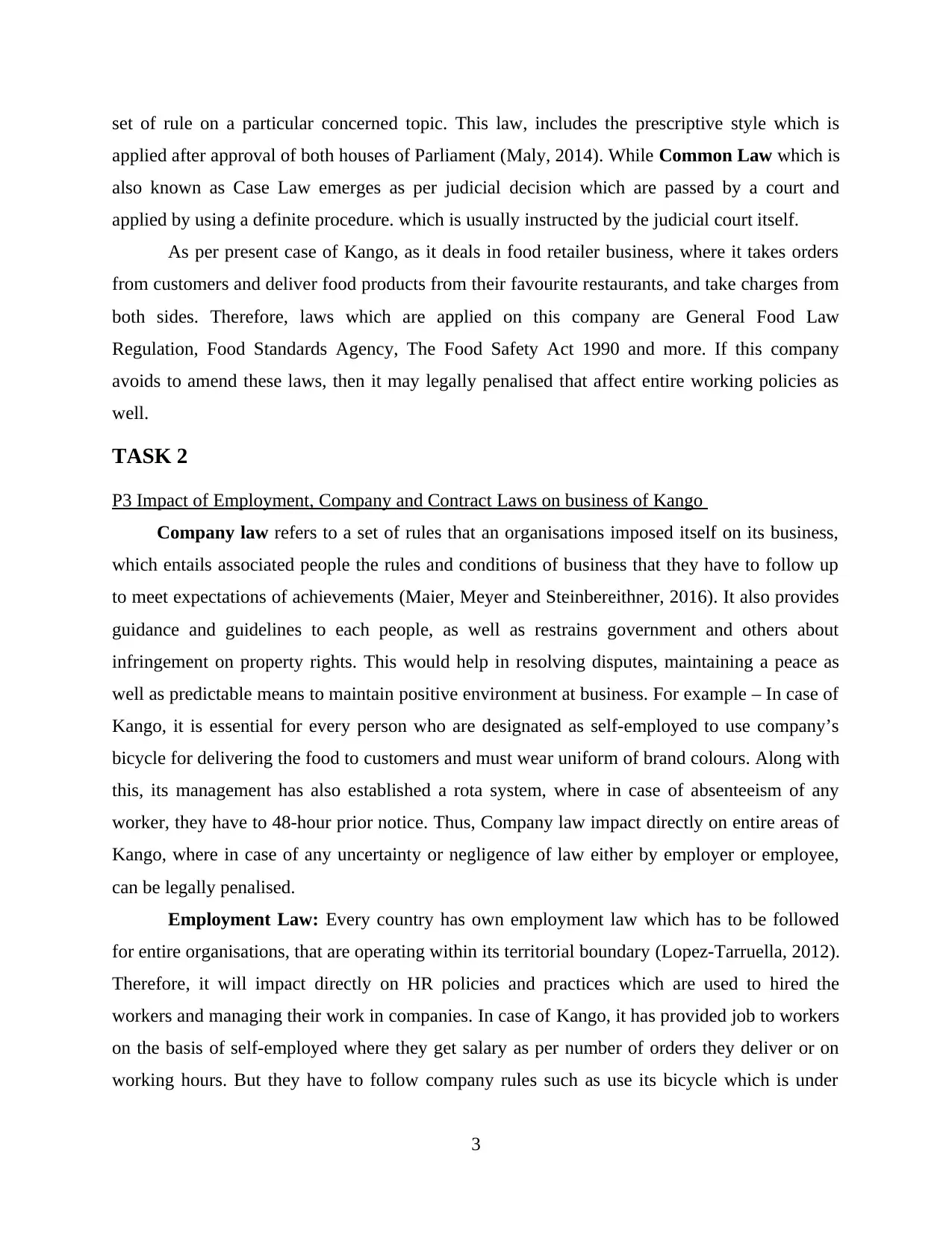
set of rule on a particular concerned topic. This law, includes the prescriptive style which is
applied after approval of both houses of Parliament (Maly, 2014). While Common Law which is
also known as Case Law emerges as per judicial decision which are passed by a court and
applied by using a definite procedure. which is usually instructed by the judicial court itself.
As per present case of Kango, as it deals in food retailer business, where it takes orders
from customers and deliver food products from their favourite restaurants, and take charges from
both sides. Therefore, laws which are applied on this company are General Food Law
Regulation, Food Standards Agency, The Food Safety Act 1990 and more. If this company
avoids to amend these laws, then it may legally penalised that affect entire working policies as
well.
TASK 2
P3 Impact of Employment, Company and Contract Laws on business of Kango
Company law refers to a set of rules that an organisations imposed itself on its business,
which entails associated people the rules and conditions of business that they have to follow up
to meet expectations of achievements (Maier, Meyer and Steinbereithner, 2016). It also provides
guidance and guidelines to each people, as well as restrains government and others about
infringement on property rights. This would help in resolving disputes, maintaining a peace as
well as predictable means to maintain positive environment at business. For example – In case of
Kango, it is essential for every person who are designated as self-employed to use company’s
bicycle for delivering the food to customers and must wear uniform of brand colours. Along with
this, its management has also established a rota system, where in case of absenteeism of any
worker, they have to 48-hour prior notice. Thus, Company law impact directly on entire areas of
Kango, where in case of any uncertainty or negligence of law either by employer or employee,
can be legally penalised.
Employment Law: Every country has own employment law which has to be followed
for entire organisations, that are operating within its territorial boundary (Lopez-Tarruella, 2012).
Therefore, it will impact directly on HR policies and practices which are used to hired the
workers and managing their work in companies. In case of Kango, it has provided job to workers
on the basis of self-employed where they get salary as per number of orders they deliver or on
working hours. But they have to follow company rules such as use its bicycle which is under
3
applied after approval of both houses of Parliament (Maly, 2014). While Common Law which is
also known as Case Law emerges as per judicial decision which are passed by a court and
applied by using a definite procedure. which is usually instructed by the judicial court itself.
As per present case of Kango, as it deals in food retailer business, where it takes orders
from customers and deliver food products from their favourite restaurants, and take charges from
both sides. Therefore, laws which are applied on this company are General Food Law
Regulation, Food Standards Agency, The Food Safety Act 1990 and more. If this company
avoids to amend these laws, then it may legally penalised that affect entire working policies as
well.
TASK 2
P3 Impact of Employment, Company and Contract Laws on business of Kango
Company law refers to a set of rules that an organisations imposed itself on its business,
which entails associated people the rules and conditions of business that they have to follow up
to meet expectations of achievements (Maier, Meyer and Steinbereithner, 2016). It also provides
guidance and guidelines to each people, as well as restrains government and others about
infringement on property rights. This would help in resolving disputes, maintaining a peace as
well as predictable means to maintain positive environment at business. For example – In case of
Kango, it is essential for every person who are designated as self-employed to use company’s
bicycle for delivering the food to customers and must wear uniform of brand colours. Along with
this, its management has also established a rota system, where in case of absenteeism of any
worker, they have to 48-hour prior notice. Thus, Company law impact directly on entire areas of
Kango, where in case of any uncertainty or negligence of law either by employer or employee,
can be legally penalised.
Employment Law: Every country has own employment law which has to be followed
for entire organisations, that are operating within its territorial boundary (Lopez-Tarruella, 2012).
Therefore, it will impact directly on HR policies and practices which are used to hired the
workers and managing their work in companies. In case of Kango, it has provided job to workers
on the basis of self-employed where they get salary as per number of orders they deliver or on
working hours. But they have to follow company rules such as use its bicycle which is under
3
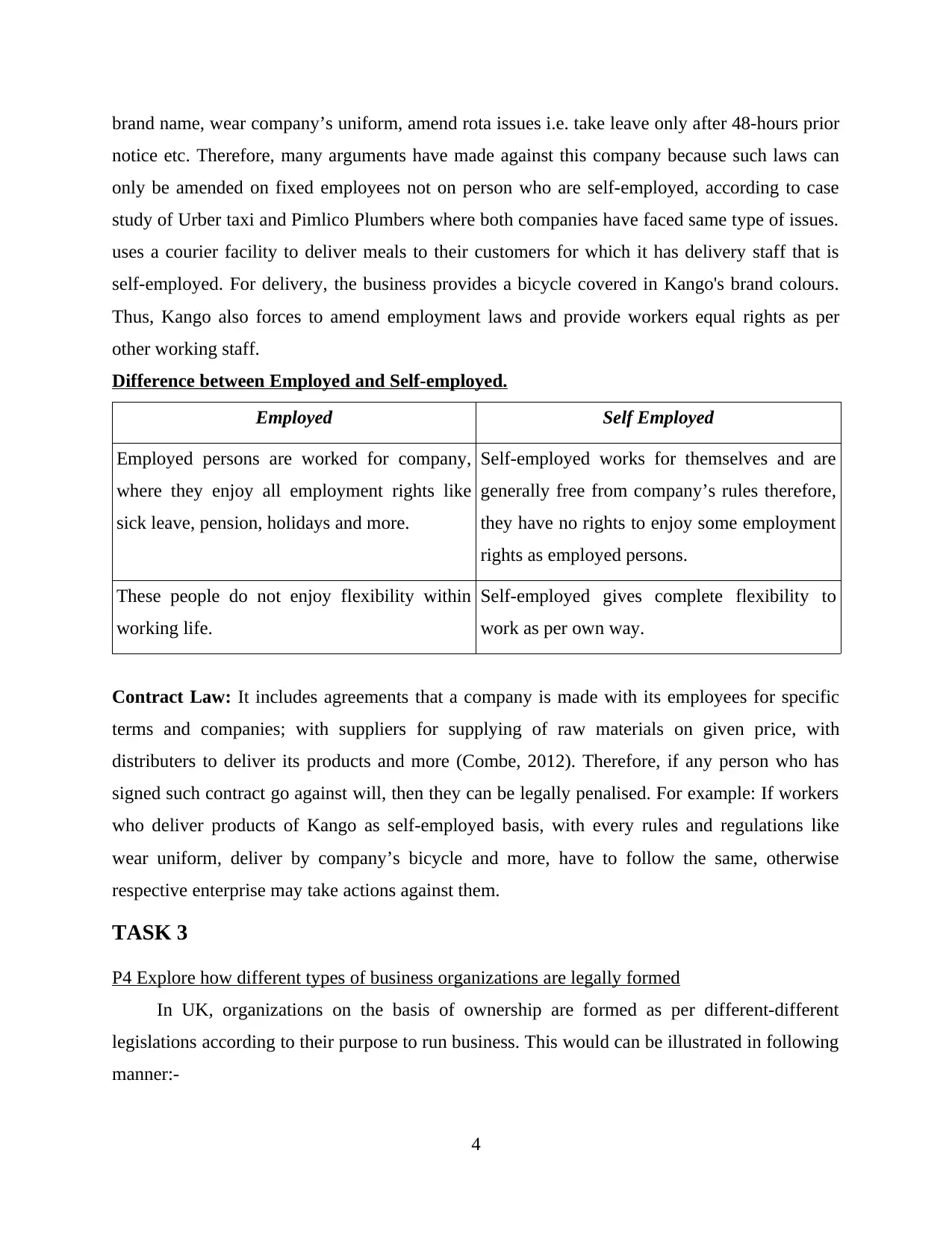
brand name, wear company’s uniform, amend rota issues i.e. take leave only after 48-hours prior
notice etc. Therefore, many arguments have made against this company because such laws can
only be amended on fixed employees not on person who are self-employed, according to case
study of Urber taxi and Pimlico Plumbers where both companies have faced same type of issues.
uses a courier facility to deliver meals to their customers for which it has delivery staff that is
self-employed. For delivery, the business provides a bicycle covered in Kango's brand colours.
Thus, Kango also forces to amend employment laws and provide workers equal rights as per
other working staff.
Difference between Employed and Self-employed.
Employed Self Employed
Employed persons are worked for company,
where they enjoy all employment rights like
sick leave, pension, holidays and more.
Self-employed works for themselves and are
generally free from company’s rules therefore,
they have no rights to enjoy some employment
rights as employed persons.
These people do not enjoy flexibility within
working life.
Self-employed gives complete flexibility to
work as per own way.
Contract Law: It includes agreements that a company is made with its employees for specific
terms and companies; with suppliers for supplying of raw materials on given price, with
distributers to deliver its products and more (Combe, 2012). Therefore, if any person who has
signed such contract go against will, then they can be legally penalised. For example: If workers
who deliver products of Kango as self-employed basis, with every rules and regulations like
wear uniform, deliver by company’s bicycle and more, have to follow the same, otherwise
respective enterprise may take actions against them.
TASK 3
P4 Explore how different types of business organizations are legally formed
In UK, organizations on the basis of ownership are formed as per different-different
legislations according to their purpose to run business. This would can be illustrated in following
manner:-
4
notice etc. Therefore, many arguments have made against this company because such laws can
only be amended on fixed employees not on person who are self-employed, according to case
study of Urber taxi and Pimlico Plumbers where both companies have faced same type of issues.
uses a courier facility to deliver meals to their customers for which it has delivery staff that is
self-employed. For delivery, the business provides a bicycle covered in Kango's brand colours.
Thus, Kango also forces to amend employment laws and provide workers equal rights as per
other working staff.
Difference between Employed and Self-employed.
Employed Self Employed
Employed persons are worked for company,
where they enjoy all employment rights like
sick leave, pension, holidays and more.
Self-employed works for themselves and are
generally free from company’s rules therefore,
they have no rights to enjoy some employment
rights as employed persons.
These people do not enjoy flexibility within
working life.
Self-employed gives complete flexibility to
work as per own way.
Contract Law: It includes agreements that a company is made with its employees for specific
terms and companies; with suppliers for supplying of raw materials on given price, with
distributers to deliver its products and more (Combe, 2012). Therefore, if any person who has
signed such contract go against will, then they can be legally penalised. For example: If workers
who deliver products of Kango as self-employed basis, with every rules and regulations like
wear uniform, deliver by company’s bicycle and more, have to follow the same, otherwise
respective enterprise may take actions against them.
TASK 3
P4 Explore how different types of business organizations are legally formed
In UK, organizations on the basis of ownership are formed as per different-different
legislations according to their purpose to run business. This would can be illustrated in following
manner:-
4
⊘ This is a preview!⊘
Do you want full access?
Subscribe today to unlock all pages.

Trusted by 1+ million students worldwide
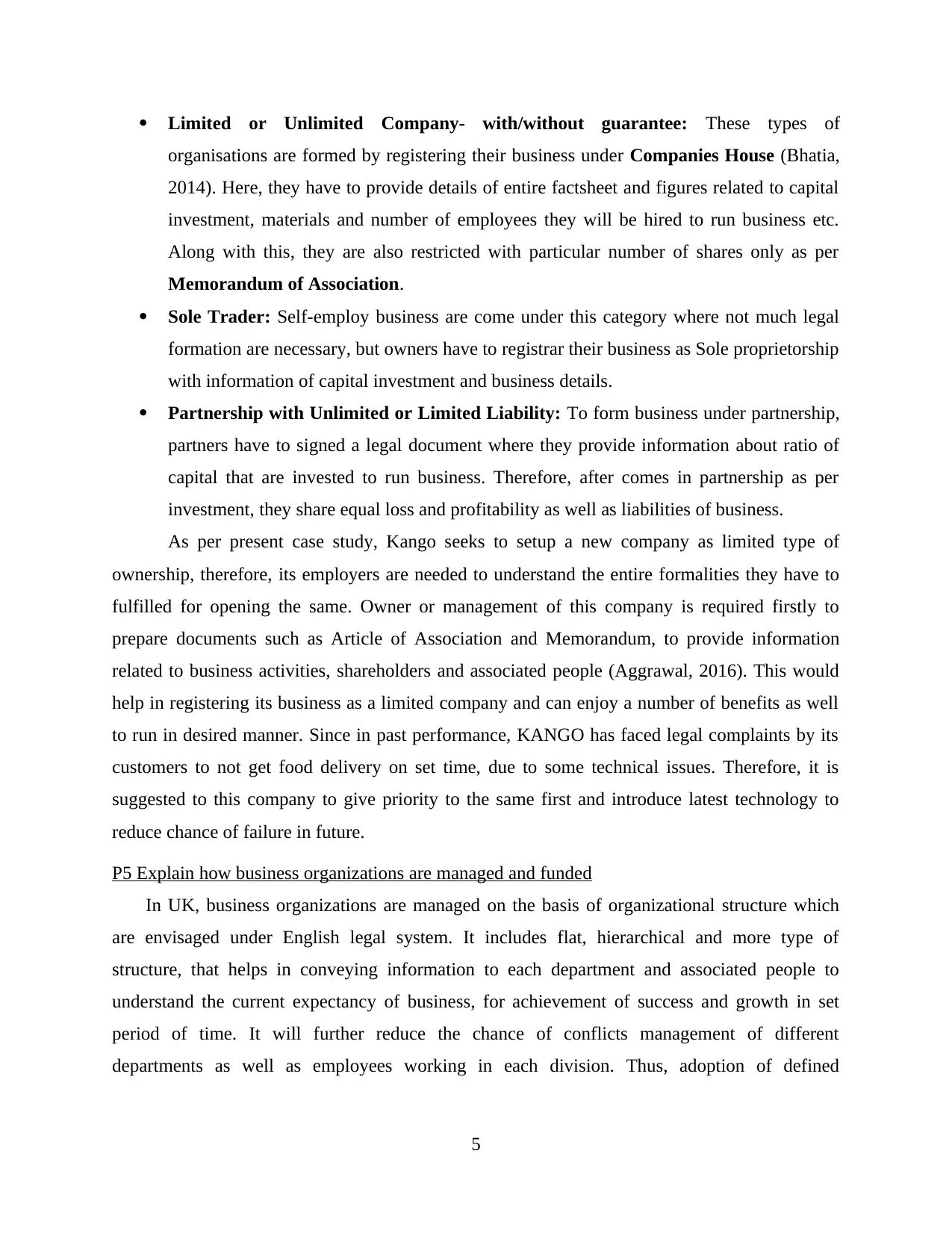
Limited or Unlimited Company- with/without guarantee: These types of
organisations are formed by registering their business under Companies House (Bhatia,
2014). Here, they have to provide details of entire factsheet and figures related to capital
investment, materials and number of employees they will be hired to run business etc.
Along with this, they are also restricted with particular number of shares only as per
Memorandum of Association.
Sole Trader: Self-employ business are come under this category where not much legal
formation are necessary, but owners have to registrar their business as Sole proprietorship
with information of capital investment and business details.
Partnership with Unlimited or Limited Liability: To form business under partnership,
partners have to signed a legal document where they provide information about ratio of
capital that are invested to run business. Therefore, after comes in partnership as per
investment, they share equal loss and profitability as well as liabilities of business.
As per present case study, Kango seeks to setup a new company as limited type of
ownership, therefore, its employers are needed to understand the entire formalities they have to
fulfilled for opening the same. Owner or management of this company is required firstly to
prepare documents such as Article of Association and Memorandum, to provide information
related to business activities, shareholders and associated people (Aggrawal, 2016). This would
help in registering its business as a limited company and can enjoy a number of benefits as well
to run in desired manner. Since in past performance, KANGO has faced legal complaints by its
customers to not get food delivery on set time, due to some technical issues. Therefore, it is
suggested to this company to give priority to the same first and introduce latest technology to
reduce chance of failure in future.
P5 Explain how business organizations are managed and funded
In UK, business organizations are managed on the basis of organizational structure which
are envisaged under English legal system. It includes flat, hierarchical and more type of
structure, that helps in conveying information to each department and associated people to
understand the current expectancy of business, for achievement of success and growth in set
period of time. It will further reduce the chance of conflicts management of different
departments as well as employees working in each division. Thus, adoption of defined
5
organisations are formed by registering their business under Companies House (Bhatia,
2014). Here, they have to provide details of entire factsheet and figures related to capital
investment, materials and number of employees they will be hired to run business etc.
Along with this, they are also restricted with particular number of shares only as per
Memorandum of Association.
Sole Trader: Self-employ business are come under this category where not much legal
formation are necessary, but owners have to registrar their business as Sole proprietorship
with information of capital investment and business details.
Partnership with Unlimited or Limited Liability: To form business under partnership,
partners have to signed a legal document where they provide information about ratio of
capital that are invested to run business. Therefore, after comes in partnership as per
investment, they share equal loss and profitability as well as liabilities of business.
As per present case study, Kango seeks to setup a new company as limited type of
ownership, therefore, its employers are needed to understand the entire formalities they have to
fulfilled for opening the same. Owner or management of this company is required firstly to
prepare documents such as Article of Association and Memorandum, to provide information
related to business activities, shareholders and associated people (Aggrawal, 2016). This would
help in registering its business as a limited company and can enjoy a number of benefits as well
to run in desired manner. Since in past performance, KANGO has faced legal complaints by its
customers to not get food delivery on set time, due to some technical issues. Therefore, it is
suggested to this company to give priority to the same first and introduce latest technology to
reduce chance of failure in future.
P5 Explain how business organizations are managed and funded
In UK, business organizations are managed on the basis of organizational structure which
are envisaged under English legal system. It includes flat, hierarchical and more type of
structure, that helps in conveying information to each department and associated people to
understand the current expectancy of business, for achievement of success and growth in set
period of time. It will further reduce the chance of conflicts management of different
departments as well as employees working in each division. Thus, adoption of defined
5
Paraphrase This Document
Need a fresh take? Get an instant paraphrase of this document with our AI Paraphraser
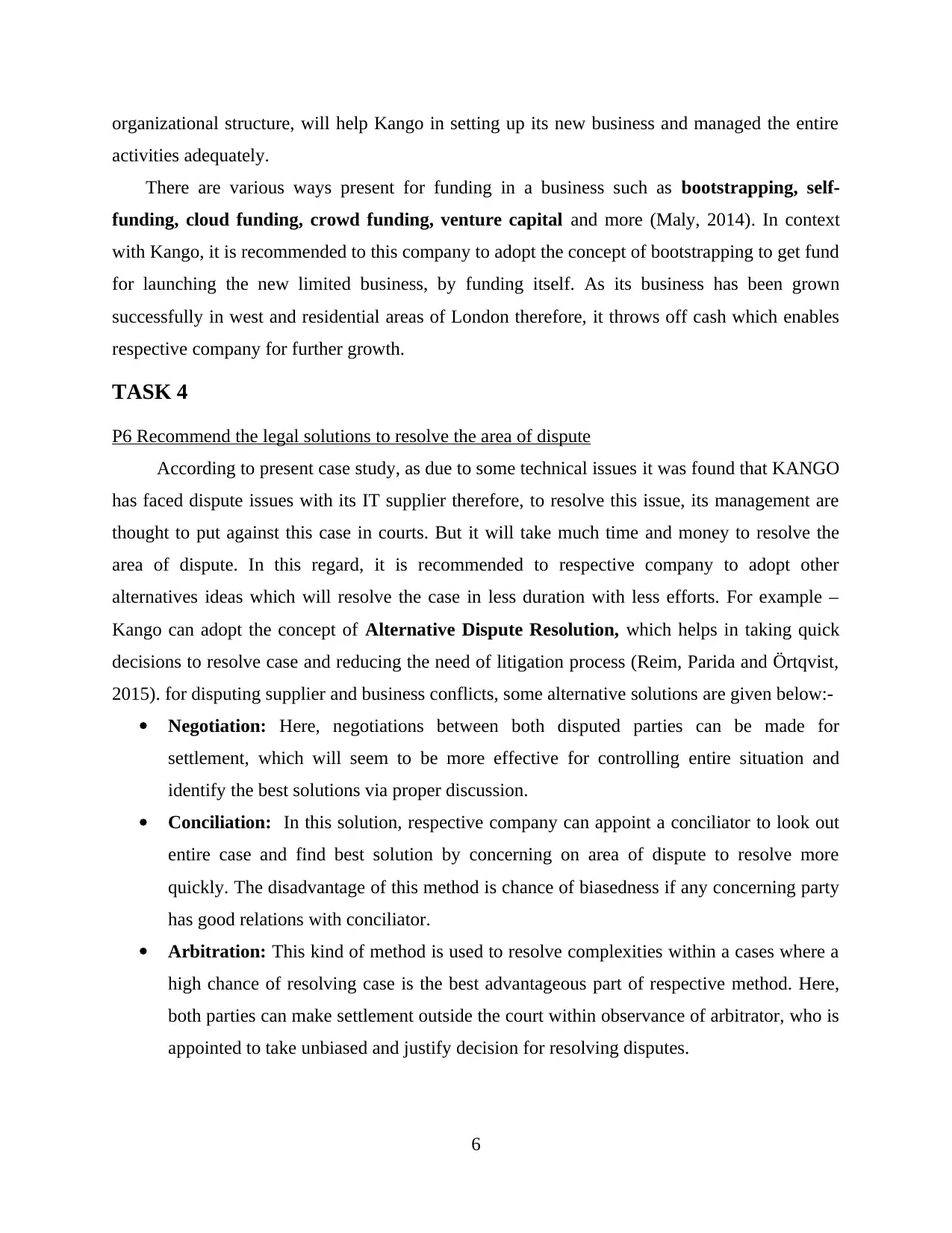
organizational structure, will help Kango in setting up its new business and managed the entire
activities adequately.
There are various ways present for funding in a business such as bootstrapping, self-
funding, cloud funding, crowd funding, venture capital and more (Maly, 2014). In context
with Kango, it is recommended to this company to adopt the concept of bootstrapping to get fund
for launching the new limited business, by funding itself. As its business has been grown
successfully in west and residential areas of London therefore, it throws off cash which enables
respective company for further growth.
TASK 4
P6 Recommend the legal solutions to resolve the area of dispute
According to present case study, as due to some technical issues it was found that KANGO
has faced dispute issues with its IT supplier therefore, to resolve this issue, its management are
thought to put against this case in courts. But it will take much time and money to resolve the
area of dispute. In this regard, it is recommended to respective company to adopt other
alternatives ideas which will resolve the case in less duration with less efforts. For example –
Kango can adopt the concept of Alternative Dispute Resolution, which helps in taking quick
decisions to resolve case and reducing the need of litigation process (Reim, Parida and Örtqvist,
2015). for disputing supplier and business conflicts, some alternative solutions are given below:-
Negotiation: Here, negotiations between both disputed parties can be made for
settlement, which will seem to be more effective for controlling entire situation and
identify the best solutions via proper discussion.
Conciliation: In this solution, respective company can appoint a conciliator to look out
entire case and find best solution by concerning on area of dispute to resolve more
quickly. The disadvantage of this method is chance of biasedness if any concerning party
has good relations with conciliator.
Arbitration: This kind of method is used to resolve complexities within a cases where a
high chance of resolving case is the best advantageous part of respective method. Here,
both parties can make settlement outside the court within observance of arbitrator, who is
appointed to take unbiased and justify decision for resolving disputes.
6
activities adequately.
There are various ways present for funding in a business such as bootstrapping, self-
funding, cloud funding, crowd funding, venture capital and more (Maly, 2014). In context
with Kango, it is recommended to this company to adopt the concept of bootstrapping to get fund
for launching the new limited business, by funding itself. As its business has been grown
successfully in west and residential areas of London therefore, it throws off cash which enables
respective company for further growth.
TASK 4
P6 Recommend the legal solutions to resolve the area of dispute
According to present case study, as due to some technical issues it was found that KANGO
has faced dispute issues with its IT supplier therefore, to resolve this issue, its management are
thought to put against this case in courts. But it will take much time and money to resolve the
area of dispute. In this regard, it is recommended to respective company to adopt other
alternatives ideas which will resolve the case in less duration with less efforts. For example –
Kango can adopt the concept of Alternative Dispute Resolution, which helps in taking quick
decisions to resolve case and reducing the need of litigation process (Reim, Parida and Örtqvist,
2015). for disputing supplier and business conflicts, some alternative solutions are given below:-
Negotiation: Here, negotiations between both disputed parties can be made for
settlement, which will seem to be more effective for controlling entire situation and
identify the best solutions via proper discussion.
Conciliation: In this solution, respective company can appoint a conciliator to look out
entire case and find best solution by concerning on area of dispute to resolve more
quickly. The disadvantage of this method is chance of biasedness if any concerning party
has good relations with conciliator.
Arbitration: This kind of method is used to resolve complexities within a cases where a
high chance of resolving case is the best advantageous part of respective method. Here,
both parties can make settlement outside the court within observance of arbitrator, who is
appointed to take unbiased and justify decision for resolving disputes.
6
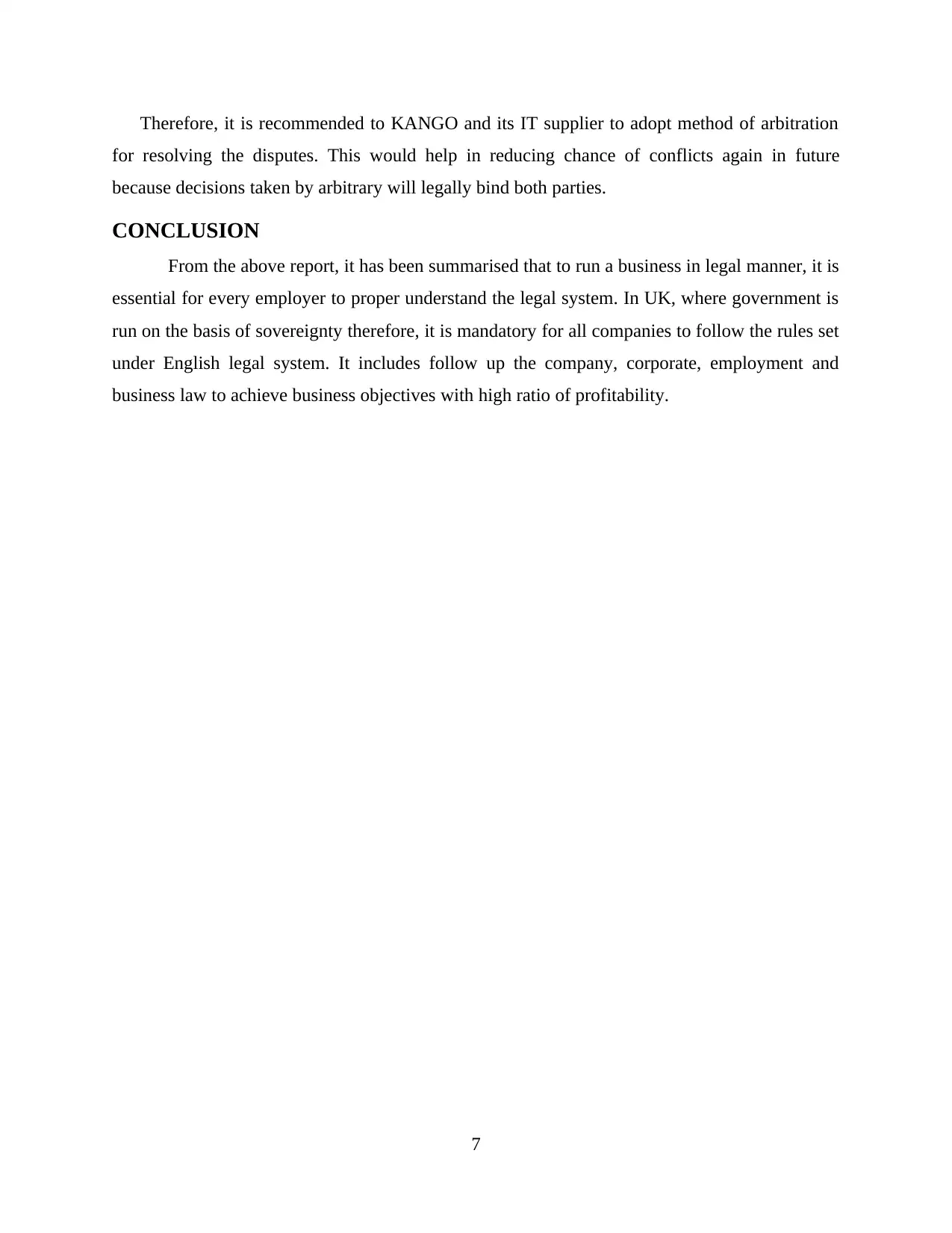
Therefore, it is recommended to KANGO and its IT supplier to adopt method of arbitration
for resolving the disputes. This would help in reducing chance of conflicts again in future
because decisions taken by arbitrary will legally bind both parties.
CONCLUSION
From the above report, it has been summarised that to run a business in legal manner, it is
essential for every employer to proper understand the legal system. In UK, where government is
run on the basis of sovereignty therefore, it is mandatory for all companies to follow the rules set
under English legal system. It includes follow up the company, corporate, employment and
business law to achieve business objectives with high ratio of profitability.
7
for resolving the disputes. This would help in reducing chance of conflicts again in future
because decisions taken by arbitrary will legally bind both parties.
CONCLUSION
From the above report, it has been summarised that to run a business in legal manner, it is
essential for every employer to proper understand the legal system. In UK, where government is
run on the basis of sovereignty therefore, it is mandatory for all companies to follow the rules set
under English legal system. It includes follow up the company, corporate, employment and
business law to achieve business objectives with high ratio of profitability.
7
⊘ This is a preview!⊘
Do you want full access?
Subscribe today to unlock all pages.

Trusted by 1+ million students worldwide
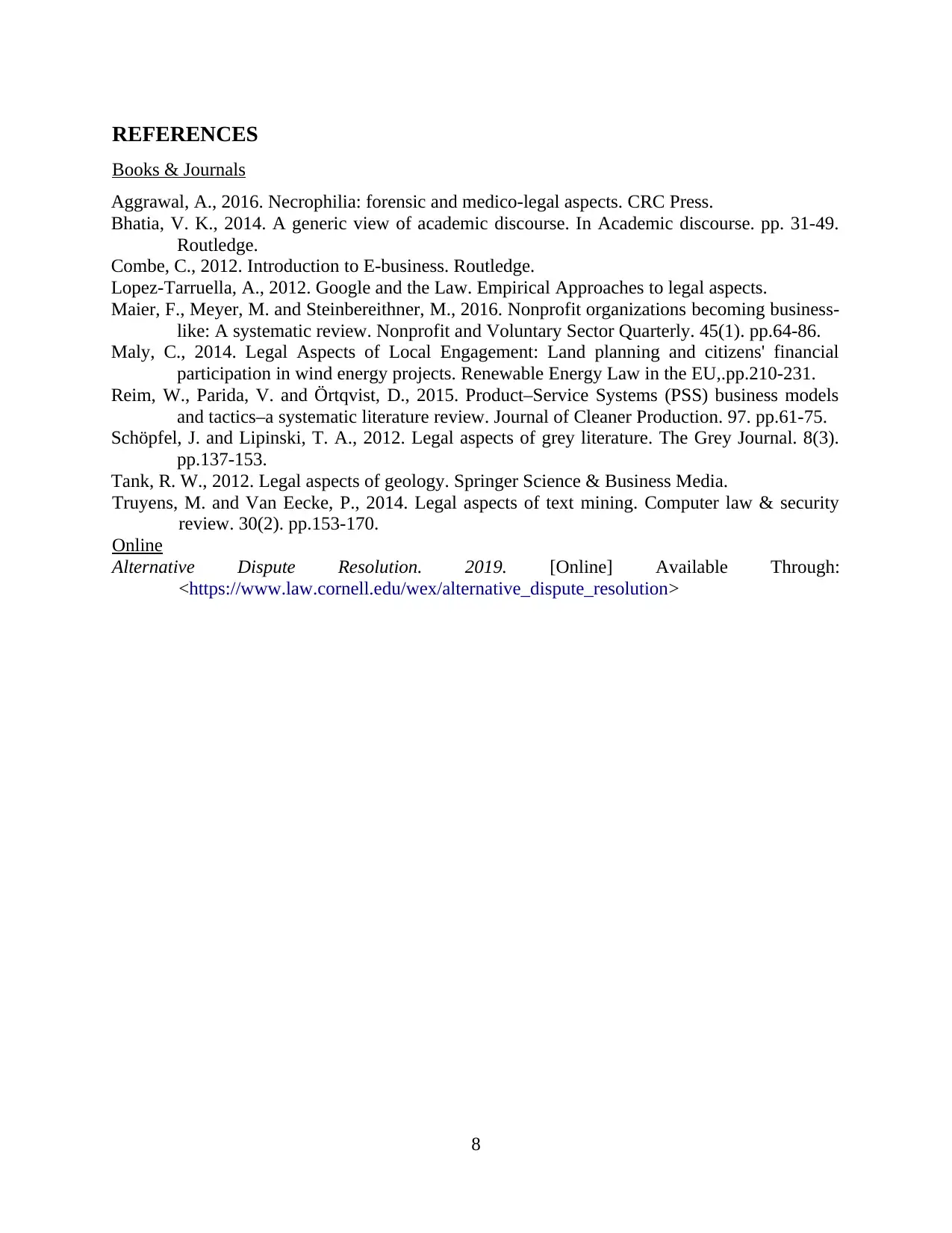
REFERENCES
Books & Journals
Aggrawal, A., 2016. Necrophilia: forensic and medico-legal aspects. CRC Press.
Bhatia, V. K., 2014. A generic view of academic discourse. In Academic discourse. pp. 31-49.
Routledge.
Combe, C., 2012. Introduction to E-business. Routledge.
Lopez-Tarruella, A., 2012. Google and the Law. Empirical Approaches to legal aspects.
Maier, F., Meyer, M. and Steinbereithner, M., 2016. Nonprofit organizations becoming business-
like: A systematic review. Nonprofit and Voluntary Sector Quarterly. 45(1). pp.64-86.
Maly, C., 2014. Legal Aspects of Local Engagement: Land planning and citizens' financial
participation in wind energy projects. Renewable Energy Law in the EU,.pp.210-231.
Reim, W., Parida, V. and Örtqvist, D., 2015. Product–Service Systems (PSS) business models
and tactics–a systematic literature review. Journal of Cleaner Production. 97. pp.61-75.
Schöpfel, J. and Lipinski, T. A., 2012. Legal aspects of grey literature. The Grey Journal. 8(3).
pp.137-153.
Tank, R. W., 2012. Legal aspects of geology. Springer Science & Business Media.
Truyens, M. and Van Eecke, P., 2014. Legal aspects of text mining. Computer law & security
review. 30(2). pp.153-170.
Online
Alternative Dispute Resolution. 2019. [Online] Available Through:
<https://www.law.cornell.edu/wex/alternative_dispute_resolution>
8
Books & Journals
Aggrawal, A., 2016. Necrophilia: forensic and medico-legal aspects. CRC Press.
Bhatia, V. K., 2014. A generic view of academic discourse. In Academic discourse. pp. 31-49.
Routledge.
Combe, C., 2012. Introduction to E-business. Routledge.
Lopez-Tarruella, A., 2012. Google and the Law. Empirical Approaches to legal aspects.
Maier, F., Meyer, M. and Steinbereithner, M., 2016. Nonprofit organizations becoming business-
like: A systematic review. Nonprofit and Voluntary Sector Quarterly. 45(1). pp.64-86.
Maly, C., 2014. Legal Aspects of Local Engagement: Land planning and citizens' financial
participation in wind energy projects. Renewable Energy Law in the EU,.pp.210-231.
Reim, W., Parida, V. and Örtqvist, D., 2015. Product–Service Systems (PSS) business models
and tactics–a systematic literature review. Journal of Cleaner Production. 97. pp.61-75.
Schöpfel, J. and Lipinski, T. A., 2012. Legal aspects of grey literature. The Grey Journal. 8(3).
pp.137-153.
Tank, R. W., 2012. Legal aspects of geology. Springer Science & Business Media.
Truyens, M. and Van Eecke, P., 2014. Legal aspects of text mining. Computer law & security
review. 30(2). pp.153-170.
Online
Alternative Dispute Resolution. 2019. [Online] Available Through:
<https://www.law.cornell.edu/wex/alternative_dispute_resolution>
8
1 out of 10
Related Documents
Your All-in-One AI-Powered Toolkit for Academic Success.
+13062052269
info@desklib.com
Available 24*7 on WhatsApp / Email
![[object Object]](/_next/static/media/star-bottom.7253800d.svg)
Unlock your academic potential
Copyright © 2020–2025 A2Z Services. All Rights Reserved. Developed and managed by ZUCOL.





